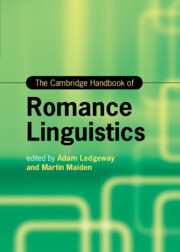Book contents
- The Cambridge Handbook of Romance Linguistics
- Cambridge Handbooks in Language and Linguistics
- The Cambridge Handbook of Romance Linguistics
- Copyright page
- Dedication
- Contents
- Figures
- Tables
- Contributors
- Abbreviations
- 1 Data, Theory, and Explanation: The View from Romance
- Part One What Is a Language?
- 2 Origins of Romance
- 3 Documentation and Sources
- 4 Variation in Romance
- Part Two Phonetics and Phonology
- Part Three Morphology
- Part Four Syntax
- Part Five Semantics and Pragmatics
- Part Six Language, Society, and the Individual
- Index
- References
2 - Origins of Romance
from Part One - What Is a Language?
Published online by Cambridge University Press: 23 June 2022
- The Cambridge Handbook of Romance Linguistics
- Cambridge Handbooks in Language and Linguistics
- The Cambridge Handbook of Romance Linguistics
- Copyright page
- Dedication
- Contents
- Figures
- Tables
- Contributors
- Abbreviations
- 1 Data, Theory, and Explanation: The View from Romance
- Part One What Is a Language?
- 2 Origins of Romance
- 3 Documentation and Sources
- 4 Variation in Romance
- Part Two Phonetics and Phonology
- Part Three Morphology
- Part Four Syntax
- Part Five Semantics and Pragmatics
- Part Six Language, Society, and the Individual
- Index
- References
Summary
This chapter explores the relation between textual attestation and comparative reconstruction in understanding the development of the Romance languages from Latin. It argues that both are required for a full understanding of the changes that have taken place, and that there are no grounds for prioritizing one above the other. The chapter reviews the debate around the Dictionnaire Étymologique Roman project and discussions concerning the periodization of Latin. It examines the relation between changes that emerge as a result of the internally motivated processes of grammaticalization and reanalysis and those induced by contact and borrowing. Attention is given to the special circumstances in which the emergent Romance vernaculars co-exist with and borrow from the standardized model of Classical Latin. Case studies discussed in this chapter include the development of grammatical gender and gender classes, perfect periphrases with the auxiliaries ‘be’ and ‘have’, constructions involving the verb ‘go’, the evolution of control and complementation with ‘want’ verbs, and the iteration of finite complementizers in the patterns which fall under the heading of recomplementation.
Keywords
- Type
- Chapter
- Information
- The Cambridge Handbook of Romance Linguistics , pp. 97 - 122Publisher: Cambridge University PressPrint publication year: 2022
References
Selected References
- 1
- Cited by



